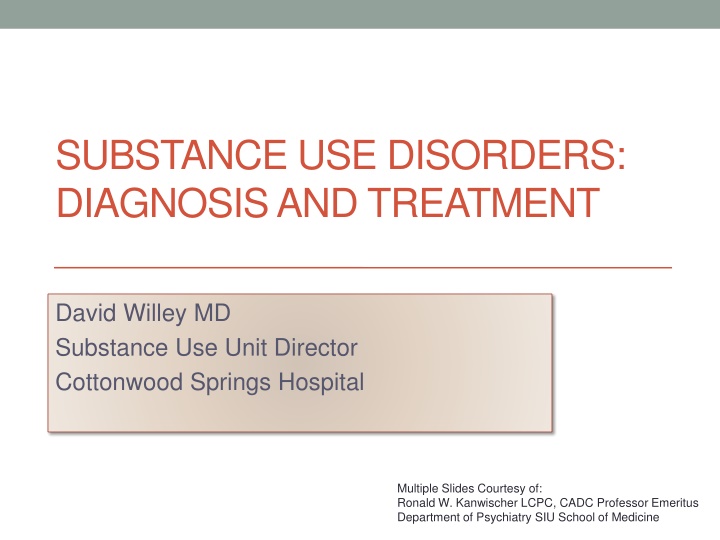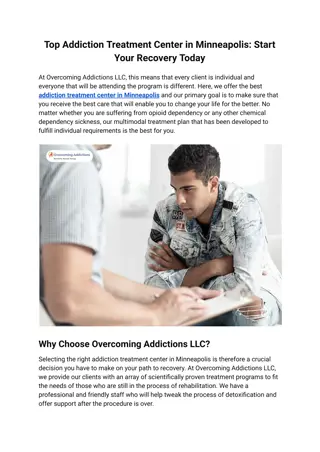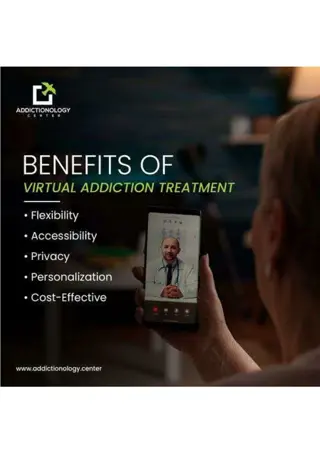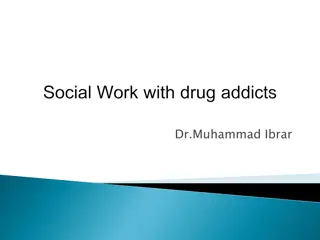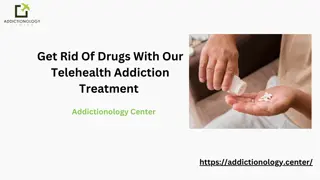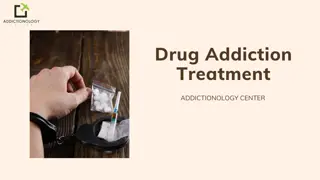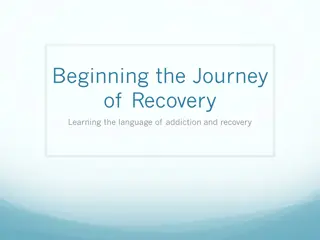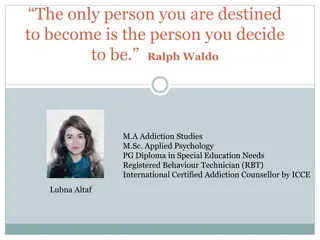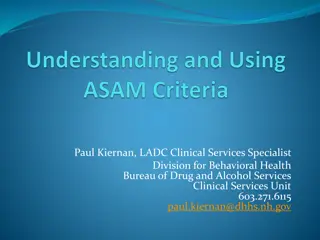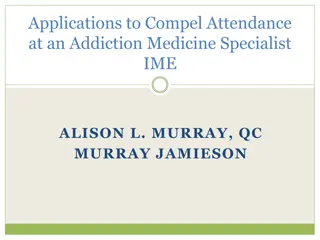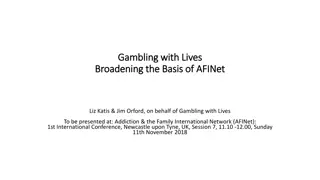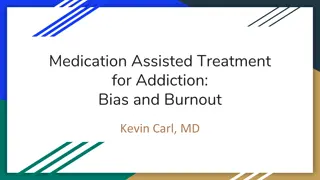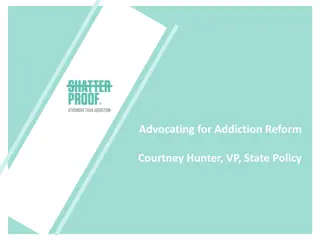Evolution of Addiction Concepts: Diagnosis and Treatment
Explore the changes in addiction concepts, DSM-V criteria, diagnostic criteria for substance use disorders, etiology, epidemiology, and treatment options including settings, pharmacotherapy, and therapeutic interventions as presented in a lecture by Dr. David Willey, MD, Substance Use Unit Director at Cottonwood Springs Hospital. Courtesy of Ronald W. Kanwischer, LCPC, CADC, Professor Emeritus at SIU School of Medicine.
Download Presentation

Please find below an Image/Link to download the presentation.
The content on the website is provided AS IS for your information and personal use only. It may not be sold, licensed, or shared on other websites without obtaining consent from the author.If you encounter any issues during the download, it is possible that the publisher has removed the file from their server.
You are allowed to download the files provided on this website for personal or commercial use, subject to the condition that they are used lawfully. All files are the property of their respective owners.
The content on the website is provided AS IS for your information and personal use only. It may not be sold, licensed, or shared on other websites without obtaining consent from the author.
E N D
Presentation Transcript
SUBSTANCE USE DISORDERS: DIAGNOSIS AND TREATMENT David Willey MD Substance Use Unit Director Cottonwood Springs Hospital Multiple Slides Courtesy of: Ronald W. Kanwischer LCPC, CADC Professor Emeritus Department of Psychiatry SIU School of Medicine
Objectives. At the end of this talk you should be able to: Describe the changes in the concept of addiction as it applies to diagnostic criteria Identify changes in DSM V as it pertains to substance use and addictive disorders Identify the diagnostic criteria for substance use disorders Describe the etiology and epidemiology of substance use disorders Describe treatment options including potential settings, pharmacotherapy and therapeutic interventions
Substance -Related and Addictive Disorder Changes
DSM V Criteria for Substance Use Disorders A problematic pattern of use leading to clinically significant impairment or distress, as manifested by at least two of the following, occurring within a 12 month period:
Substance Use Disorders Impaired Control: Using larger amounts or for longer time than intended Persistent desire or unsuccessful attempts to cut down or control use Great deal of time obtaining, using, or recovering Craving or strong desire or urge to use
Substance Use Disorders Social Impairment: Fail to fulfill major roles (work, school, home) Persistent social or interpersonal problems caused by substance use Important social, occupational, recreational activities given up or reduced Risky Use of the Substance: Use in physically hazardous situations Use despite physical or psychological problems caused by use
Substance Use Disorders Pharmacological Criteria: Tolerance as defined by either of the following: Need to use an increased amount of a substance in order to achieve the desired effect OR Markedly diminished effect with continued use of the same amount of the substance Withdrawal as manifested by either of the following: The characteristic withdrawal syndrome of the substance OR The substance is taken to relieve or avoid withdrawal symptoms
Substance Classes Alcohol Caffeine Cannabis Hallucinogens PCP others Inhalants Opioids Sedatives, hypnotics, and anxiolytics Stimulants Tobacco Other Gambling
Substance-Related Disorders 2 Groups: Substance Use Disorders Previously split into abuse or dependence Involves: impaired control, social impairment, risky use, and pharmacological criteria Substance-Induced Disorders
Substance-Induced Disorders Intoxication Withdrawal Psychotic Disorder Bipolar Disorder Depressive Disorder Anxiety Disorder Sleep Disorder Delirium Neurocognitive Sexual Dysfunction
Intoxication Reversible substance-specific syndrome due to recent ingestion of a substance Behavioral/psychological changes due to effects on CNS developing after ingestion: ex. Disturbances of perception, wakefulness, attention, thinking, judgement, psychomotor behavior and interpersonal behavior Not due to another medical condition or mental disorder Does not apply to tobacco
Clinical picture of intoxication depends on: Substance Dose Route of Administration Duration/chronicity Individual degree of tolerance Time since last dose Person s expectations of substance effect Contextual variables
Withdrawal Substance-specific syndrome problematic behavioral change due to stopping or reducing prolonged use Physiological & cognitive components Significant distress in social, occupational or other important areas of functioning Not due to another medical condition or mental disorder No withdrawal: PCP; other hallucinogens; inhalants
Neuroadaptation: Refers to underlying CNS changes that occur following repeated use such that person develops tolerance and/or withdrawal Pharmacokinetic adaptation of metabolizing system Pharmacodynamic ability of CNS to function despite high blood levels
Tolerance Need to use an increased amount of a substance in order to achieve the desired effect OR Markedly diminished effect with continued use of the same amount of the substance
Substance-Induced Mental Disorder Potentially severe, usually temporary, but sometimes persisting CNS syndromes Context of substances of abuse, medications, or toxins Can be any of the 10 classes of substances
Substance-Induced Mental Disorder Clinically significant presentation of a mental disorder Evidence (Hx, PE, labs) During or within 1 month of use Capable of producing mental disorder seen Not an independent mental disorder Preceded onset of use Persists for substantial time after use (which would not expect)
Epidemiology: Prevalence NIDA 04: 22.5M > 12yo substance-related d/o 15M Alcohol Dependence or Abuse Start at earlier age (<15yo), more likely to become addicted ex. alcohol: 18% vs. 4% (if start at 18yo or older) Rates of abuse vary by age: 1% (12yo) - 25% (21yo) - 1% (65yo) Men; American Indian; whites; unemployed; large metro areas; parolees
Epidemiology (cont.) ETOH - $300 billion/year 13 million require treatment for alcohol 5.5 million require treatment for drug use 2.5% population reported using Rx meds nonmedically within past month
Epidemiology (cont.) 40% of hospital admission have alcohol or drugs associated 25% of all hospital deaths 100,000 deaths/year Intoxication is associated with 50% of all MVAs, 50% of all DV cases and 50% of all murders
ER Visits (NIDA 09) 1.2M: non-medical use of pharmaceuticals 660K: alcohol 425K: cocaine 380K: marijuana 210K: heroin 93K: stimulants
Etiology Multiple interacting factors influence using behavior and loss of decisional flexibility Not all who become dependent experience it same way or motivated by same factors Different factors may be more or less important at different stages (drug availability, social acceptance, peer pressure VS personality and biology)
Etiology Brain Disease changes in structure and neurochemistry transform voluntary drug-using compulsive Changes proven but necessary/sufficient? (drug- dependent person changes behavior in response to positive reinforcers) Psychodynamic: disturbed ego function (inability to deal with reality)
Etiology Self-medication EtOH - panic; opioids -anger; amphetamine - depression Genetic (well-established with alcohol) Conditioning: behavior maintained by its consequences Terminate aversive state (pain, anxiety, w/d) Special status Euphoria Secondary reinforcers (ex. Paraphernalia)
Etiology Receptors Too little endogenous opioid activity (ie low endorphins) or too much endogenous opioid antagonist activity = increased risk of dependence. Normal endogenous receptor but long-term use modulates, so need exogenous substance to maintain homeostasis. Neurotransmitters o Opioid o Catecholamines o GABA o Serotonin Pathways
Learning and Physiological Basis for Dependence After using drugs or when stop leads to a depleted state resulting in dysphoria and/or cravings to use, reinforcing the use of more drug. Response of brain cells is to downregulate receptors and/or decrease production of neurotransmitters that are in excess of normal levels.
Typical Presentation and Course: Present in acute intoxication, acute/chronic withdrawal or substance induced mood, cognitive disorder or medical complications Abstinence depends on several factors: social, environmental, internal factors (presence of other comorbid psychiatric illnesses) Remission and relapses are the rule (just like any other chronic medical illness) Frequency, intensity and duration of treatment predicts outcome 70 % eventually able to abstain or decrease use to not meet criteria
Options for where to treat Hospitalization- -Due to drug OD, risk of severe withdrawal, medical comorbidities, requires restricted access to drugs, psychiatric illness with suicidal ideation Residential treatment unit -No intensive medical/psychiatric monitoring needs -Require a restricted environment -Partial hospitalization Outpatient Program -No risk of med/psych morbidity and highly motivated patient
Treatment Manage Intoxication & Withdrawal Intoxication Ranges: euphoria to life-threatening emergency Detoxification outpatient: "social detox program inpatient: close medical care preparation for ongoing treatment
Treatment Behavioral Interventions (target internal and external reinforcers) Motivation to change (MI) Group Therapy Individual Therapy Contingency Management Self-Help Recovery Groups (AA) Therapeutic Communities Aversion Therapies Family Involvement/Therapy Twelve-Step Facilitation Relapse Prevention
Treatment Pharmacologic Intervention Treat Co-Occurring Psychiatric Disorders 50% will have another psychiatric disorder Treat Associated Medical Conditions cardiovascular, cancer, endocrine, hepatic, hematologic, infectious, neurologic, nutritional, GI, pulmonary, renal, musculoskeletal
